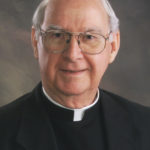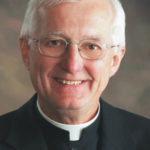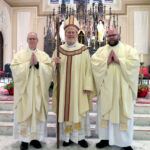By Sarah Adams
Gray Space Graces Column
In a world that seems more polarized than ever, how can we engage with one another in a constructive way? How can we better understand and be better understood? Jesus tells us that he came so that we may have life and have it more abundantly (John 10:10). How can we accept and live the abundant lives that Jesus so deeply desires to give us?

Welcome to the new column, “Gray Space Graces.” I’m Sarah, and I’m so glad you’re here. Last November, The Catholic Messenger editor asked me to write a reflection for the third Sunday of Advent. As I began to brainstorm my focus from that week’s readings, this idea of “gray area” came to mind. I’m still trying to understand what it means and why it feels so important, but here’s my best try: the gray area is the space of the in-between, the liminal. It sometimes feels like tension and at other times, confusion. If we choose to spend time wrestling (and resting) in this gray area, I think we may learn more about what it means to be a human living the abundant life that God offers us.
I hope you will walk with me on this journey to explore together what this gray space is all about and what it can teach us about ourselves, others and God. As this column unfolds, it may include stories of my own life as well as examples that I find in books, articles and other people.
Recently, I read a book called, “The Anthropocene Reviewed,” by John Green. In one chapter, he explores the way in which we experience the news today. Green writes, “News focuses on what is new, and rarely the context behind it … there was [is] so much news. News that was [is] forever breaking — that there was [is] never time for context.”
Green tells of his experience living with a friend during the 2003 U.S. invasion of Iraq. His roommate was from Kuwait and had family in Iraq. One evening they were watching cable news coverage of the war when Green’s roommate began laughing. When asked what was funny, he explained that the newscaster, who stood in front of a graffitied wall reporting on the “anger and hatred in the streets,” had a message behind him that translated to, “happy birthday sir, despite the circumstances.” I think the way the news in our modern world functions is representative of a larger issue. As Green observes, we rarely take the time for the context we need to truly understand a situation, concept or person. We wish to know what is going on but forget to ask why it’s happening in the first place.
The word “context” is a combination of the Latin words “con” (together) and “textre” (to weave). So, when we take the time to learn context, we consider as many “threads” as we can and try to understand how they are woven together. Our model in this endeavor is the ultimate weaver, the one who created us to be relational — to crave connection and belonging.
Jesus, in his earthly life, situated himself directly in gray areas and wove together what had been previously seen as “un-weavable.” Jesus greatly loved a diverse group of followers: women and men, old and young, poor and rich, Roman and Jewish, scholar and illiterate. He understood the ministry of presence — being with people as they are. In doing this, Jesus showed us what abundant life looks like. It looks like intentionally being with each other — even beyond our comfort zones, even in tension, even with confusion, even in disagreement. What would it look like for you to step into the gray area today? Starting up a conversation with someone waiting in line next to you? Calling a friend that you had a disagreement with? Asking a family member why they feel the way they do about a certain issue? Doing more research on a situation that you have your mind made up about?
Jesus is inviting us into the gray space, into abundant life. Will we dare to enter?
(Sarah Adams is social media coordinator for the Diocese of Davenport.)











